|
Miscellaneous Industrial Railroads |
|
|
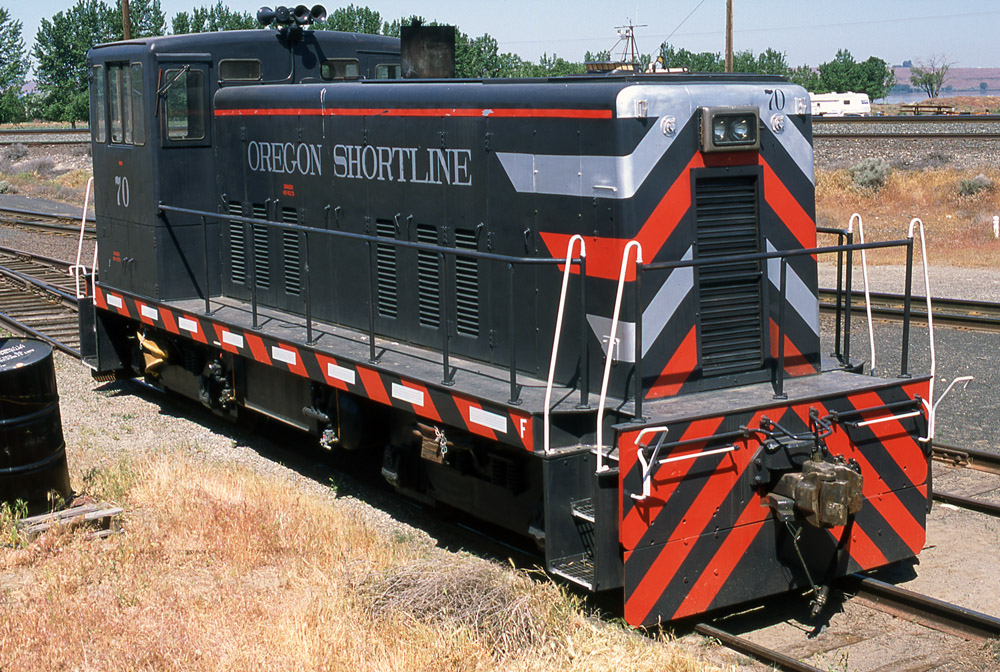 |
|
"Oregon Short Line" General Electric 70-tonner #70 at Boardman, Oregon, on 9 May 2013. Keith E. Ardinger photo.
|
|
|
This page will profile the smaller industrial railroad operations in eastern Oregon that aren't large enough to warrant an individual page or section, or which there is little recorded information. |
|
|
Les Dalles Portage Railroad The U.S. Army Corps of Engineers completed The Dalles Dam across the Columbia River between Oregon and Washington in 1957. Increasing tourism to the dam as the 1960s rolled into the 1970s prompted the agency to start considering options for ways to safely move visitors to and from a couple day use parks they built around the dam. The Corps quickly focused on a little less than two miles of railroad running from a connection with the Union Pacific mainline out across the face of the powerhouse that had been used in the initial construction but then left largely abandoned. The first part of this line was originally UP main line retired when that road effected a line change above the level of the dam and reservoir, and the rest had been built during the dam construction. Mostly volunteer crews, consisting largely of local high school and college students, started repairing the tracks, while the dam's mechanical staff rebuilt an old flatcar on the property left over from the construction to haul people. The shop crews were split as to whether the car should be enclosed or open, resulting in the car being built half of each. The Corps found a surplus General Electric 25-ton diesel switcher from the U.S. Navy Station in China Lake, California, which they secured and brought to the dam. The railroad commenced operations on 20 July 1973. 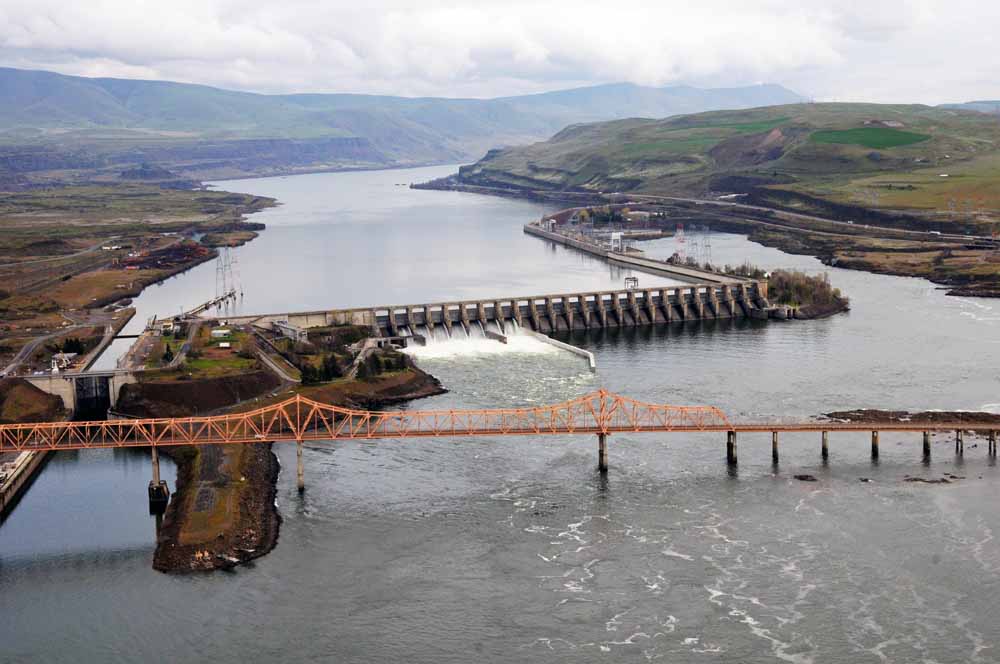
An overview of The Dalles Dam, looking east up the river. The railroad started just out of view to the right of this picture, then ran away from the camera along the Oregon side of
the river before looping onto the dam structure and coming back towards the camera, terminating at the park on the small island to the right of the spillways. Army Corps of Engineers photo. 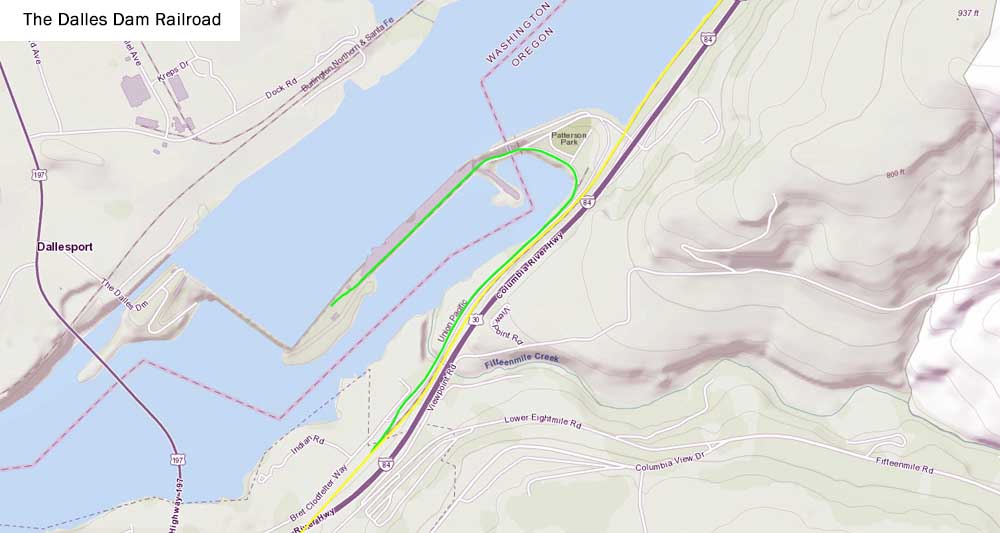 Map of The Les Dalles Portage Railroad. 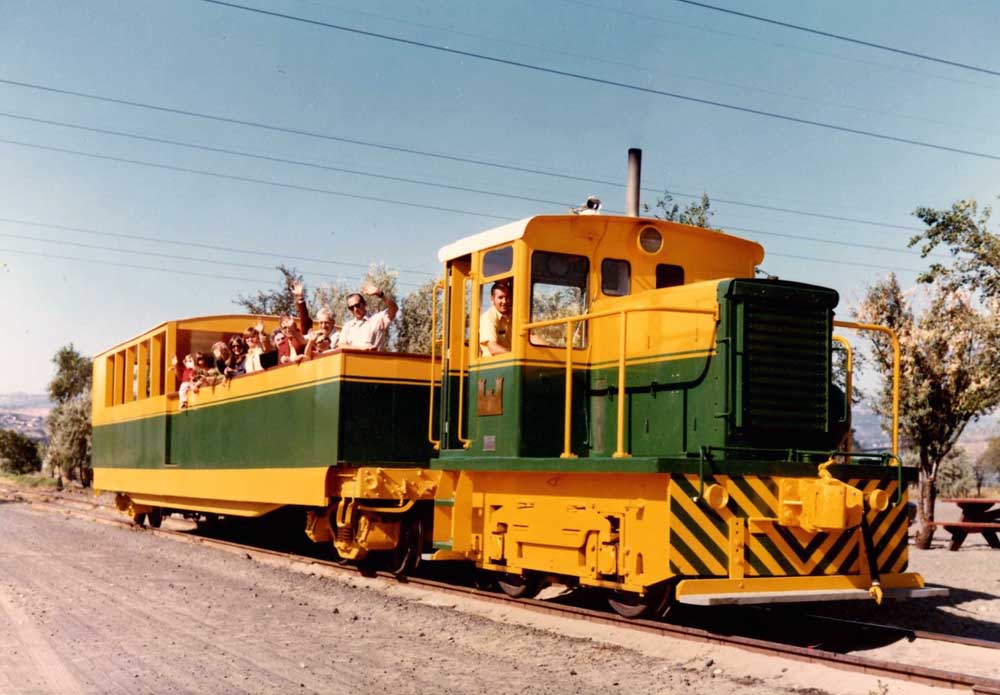 The Les Dalles Portage Railroad train in its original configuration and paint. Army Corps of Engineers photo. 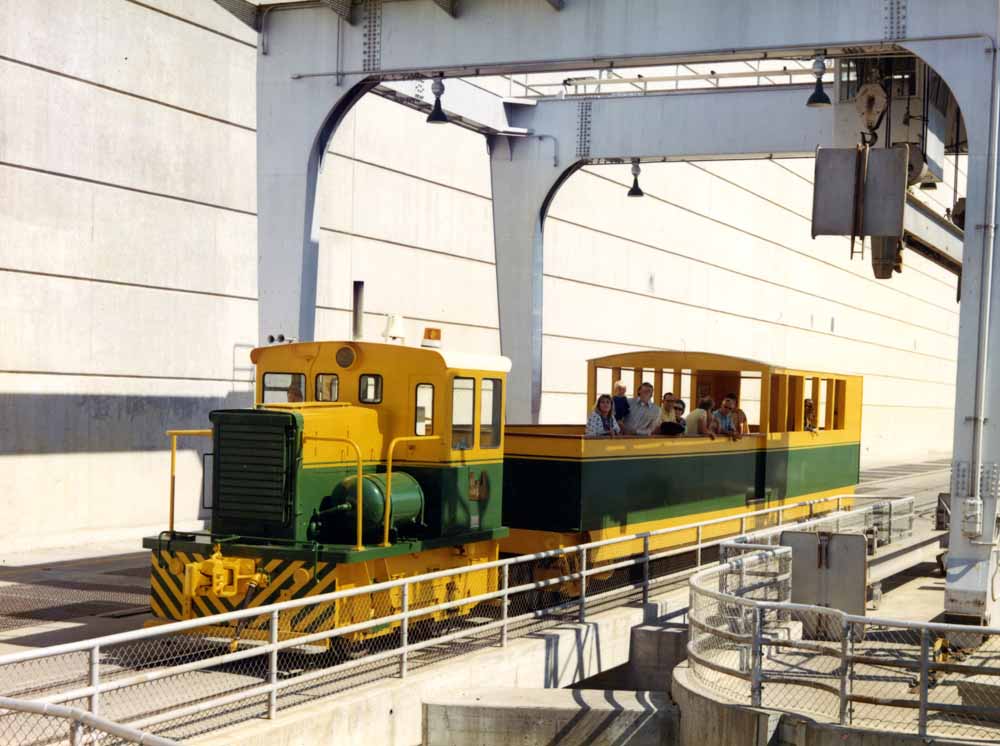 The train along the face of the powerhouse. Army Corps of Engineers photo. 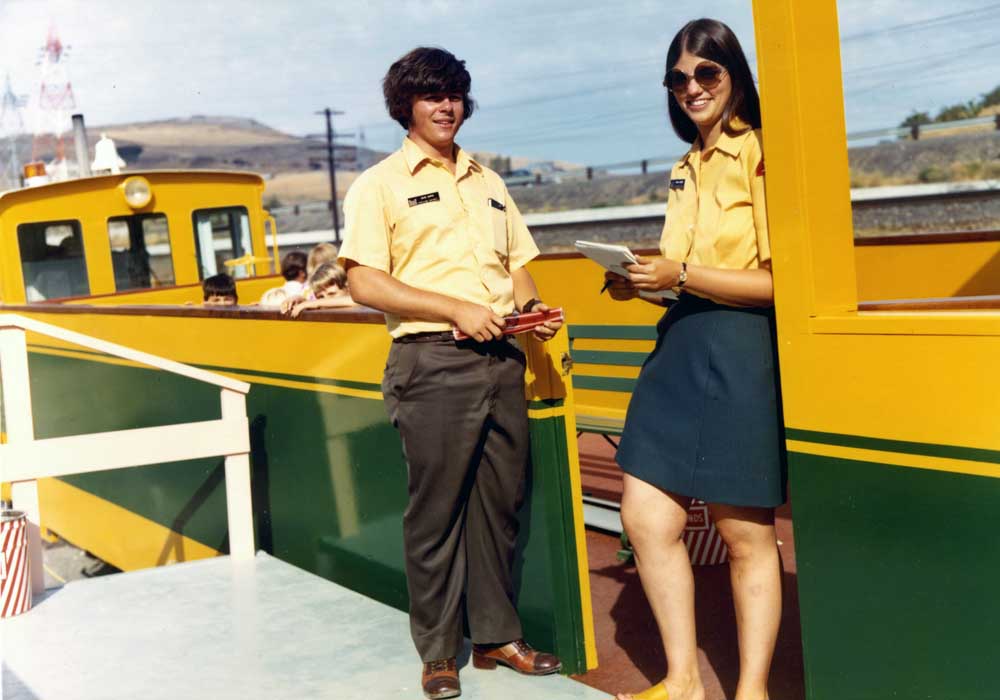 Two of the local students that originally served as tour guides on the train. Army Corps of Engineers photo.
The train started the ride every thirty minutes from a dirt parking lot not far off Interstate 84 and went east along the Oregon side of the river for a little less than a mile, where
it swung north on a tight curve through Patterson Park, home to some duck ponds and picnic tables. Shortly after passing the park the tracks started onto the dam structure itself, then
shortly thereafter crossed into the state of Washington. The train then progressed across the face of the powerhouse to a small island that lay between that structure and the spillways,
where the tracks ended at Westrick Park. In addition to the parks, the train also provided access to tours of the power turbines and fish ladder. The locomotive pulled the train out to
the end of the line and then pushed it back to the starting point. The biggest visual change to the train happened in 1976 when the Corps repainted the locomotive and car into a red, white, and blue Bicentennial scheme that the equipment would wear for the rest of its existence. A few years later the Corps purchased from the Union Pacific a wood caboose that had spent many years on the East Portland Traction Company. The dam staff and volunteers beautifully rebuilt the car and added it to the rear of the train. In 1981 the Corps built an official visitor's center for the dam at the dirt lot from which the train started each run. 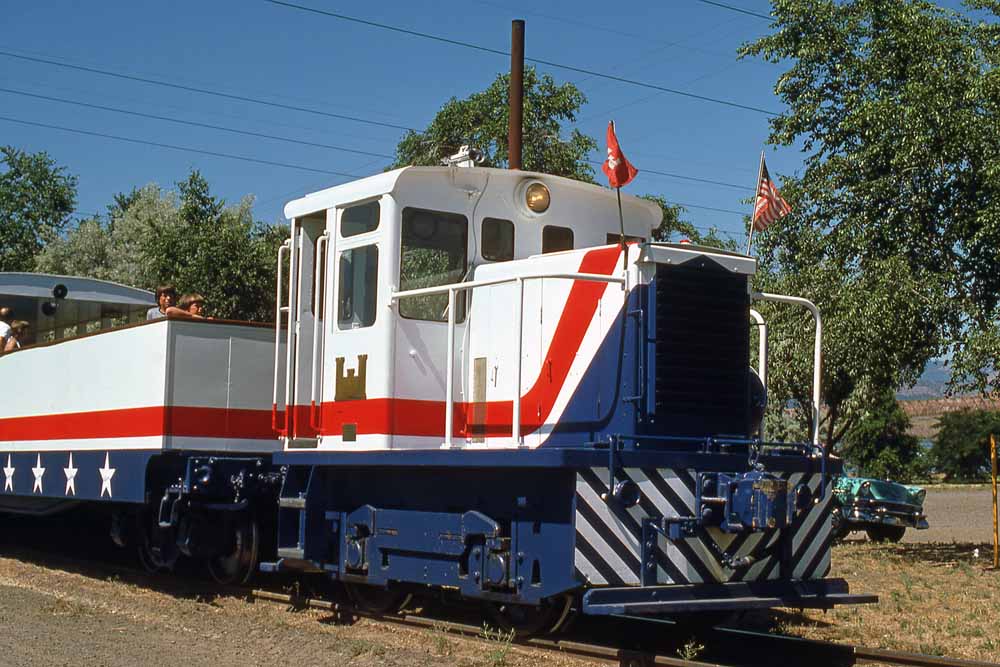 The train in its fresh red, white, and blue paint on 26 June 1976. Alan Miller photo. 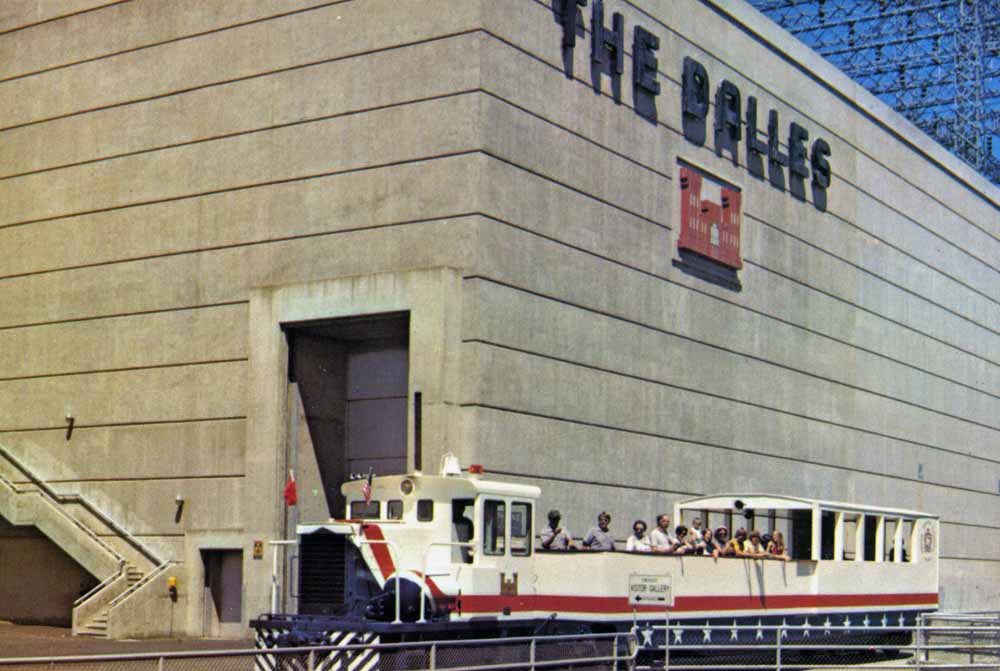 The train passing the end of the power house. Army Corps of Engineers photo. 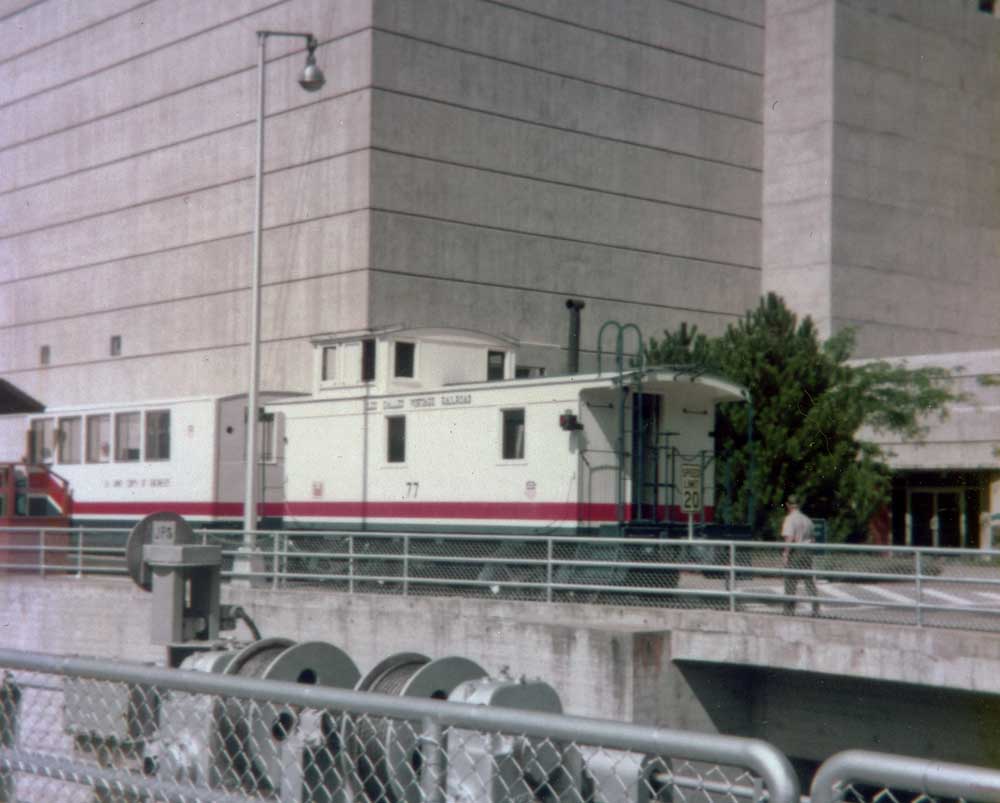 The caboose around 1986. Mary Swann photo. 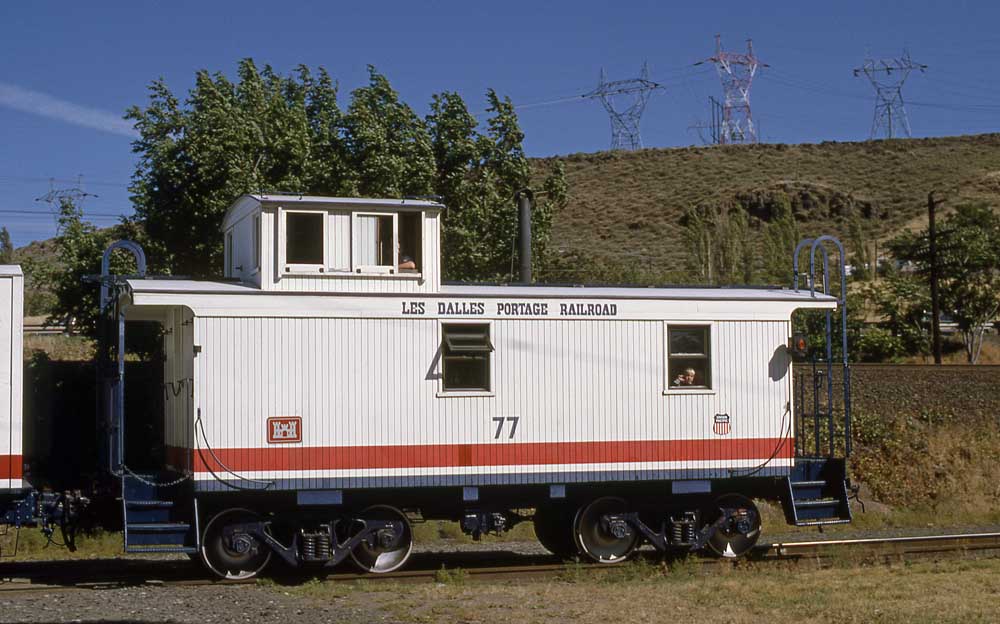 The caboose on 2 July 1994. Keith E. Ardinger photo. 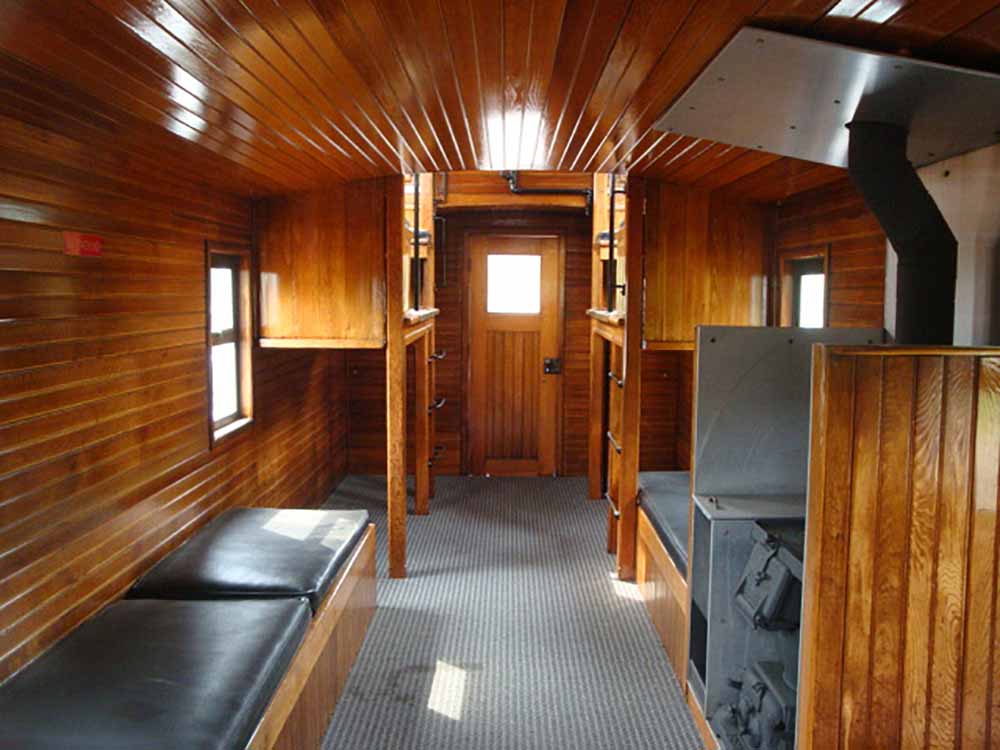 The inside of the caboose. Army Corps of Engineers photo. 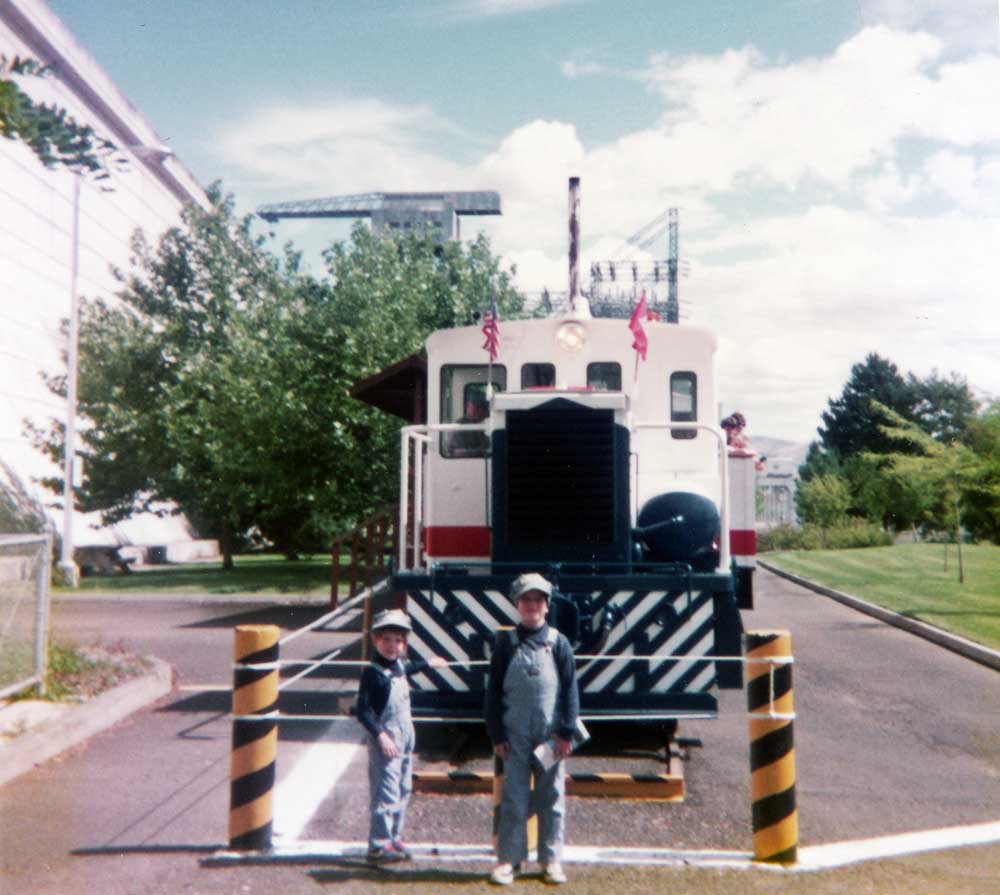 The operator of this website and his brother at the end of track about 1986. Mary Swann photo.
The 25-tonner had always given the railroad trouble, and I remember several times planned rides on the train got dashed because
the locomotive was yet again broken down. The Corps went looking for a replacement locomotive in the late 1980s and eventually
found a recently rebuilt 44-ton General Electric switcher at a Marine base in Barstow, California. The larger locomotive
replaced the original locomotive upon its arrival. 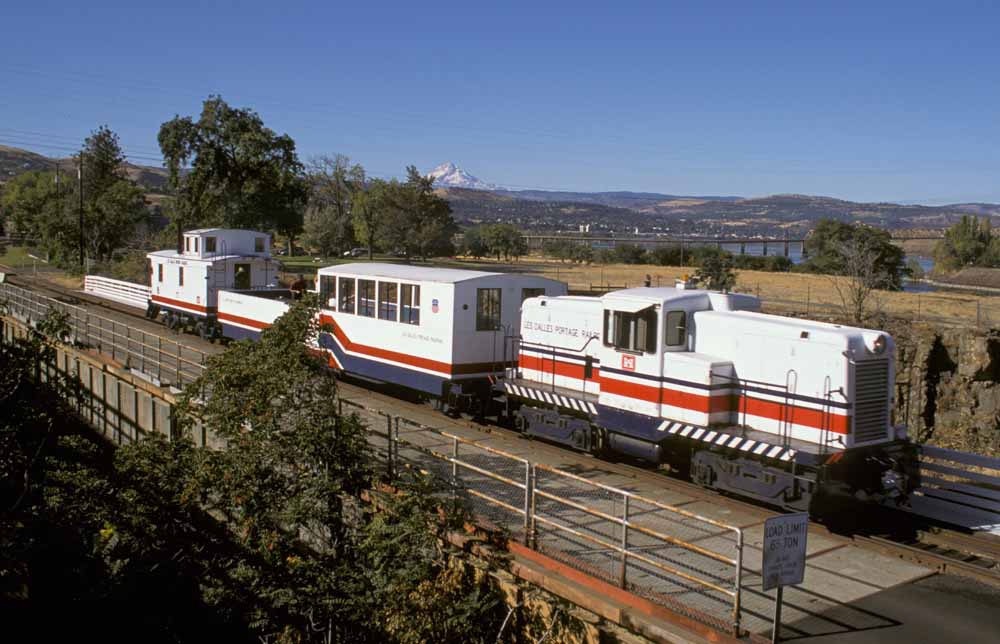 The Dalles Dam train in its final configuration. L.A. Scrafford/Army Corps of Engineers photo.
Beginning of the end of the railroad started shortly after the events of 11 September 2001, when security concerns ended some of
the tours and unescorted access to parts of the dam. The train thereafter only ran to the loading platform at the east end of the
powerhouse. The final end came in 2005 when the caboose derailed during a reverse move back to the Visitor's Center during a private
chartered event, which prompted a safety inspection of and complete reevaluation of the railroad. The inspections determined the railroad
required a lot of work in order to restore safe operations, and the Corps did not have the budget to do the work, while the overall evaluation
reinforced long-running concerns over the railroad, including costs and security concerns. The railroad immediately suspended all operations,
and the Corps stored the train set under a tarp while they considered options. By 2009 the Corps decided to retire the railroad permanently,
and the locomotive and passenger car were sold and trucked off the line while the agency decided to retain the caboose for display at Patterson
Park. The Corps removed almost all of the railroad's remaining track in 2011, with parts of the grade converted into an extension of The Dalles
Riverfront Trail. Documents prepared for this grade conversion described a potential partial restoration of public access to parts of the dam the
railroad once provided using battery powered rubber tired vehicles, though that has yet to happen. |
|
|
|
Port of Morrow Morrow County voters approved creating a Port District in 1958. The Port acquired 12,000 acres of land just east of Boardman, Oregon, which provided easy access to Interstate 84, the Columbia River, and the Union Pacific main line. Development of a large industrial park started in the late 1960s, which shortly included a network of railroad spurs built throughout the complex. Union Pacific provided the switching service to the Port until around 2010 when Frontier Rail won the contract and commenced operations. Frontier initially set up Oregon Rail Connect to handle the operations. The corporate structure has evolved several times since, and the railroad operation today is underneath the Columbia Rail banner along with several other contract switching and shortline railroad operations. UP's main line splits the industrial park into two separate operations. Most of the industrial switching happens on the south side of the main line, where numerous industrial spurs handle a lot of products related to the food and agricultural industries. Customers on the north side include a corn ehanol plant, grain transloads to barges, and team tracks where various traffic ranging from windmill blades and parts to military shipments to and from the nearby Umatilla Army Depot are handled. 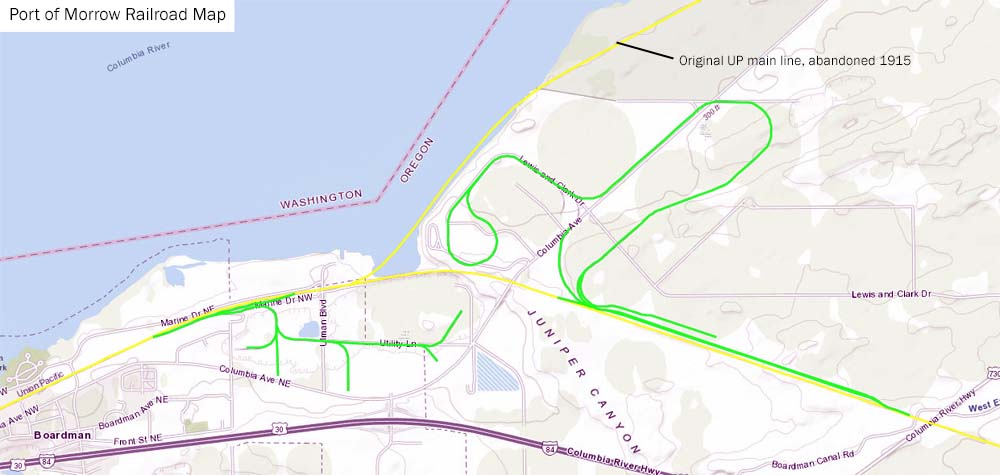 Map of the Port of Morrow railroad. 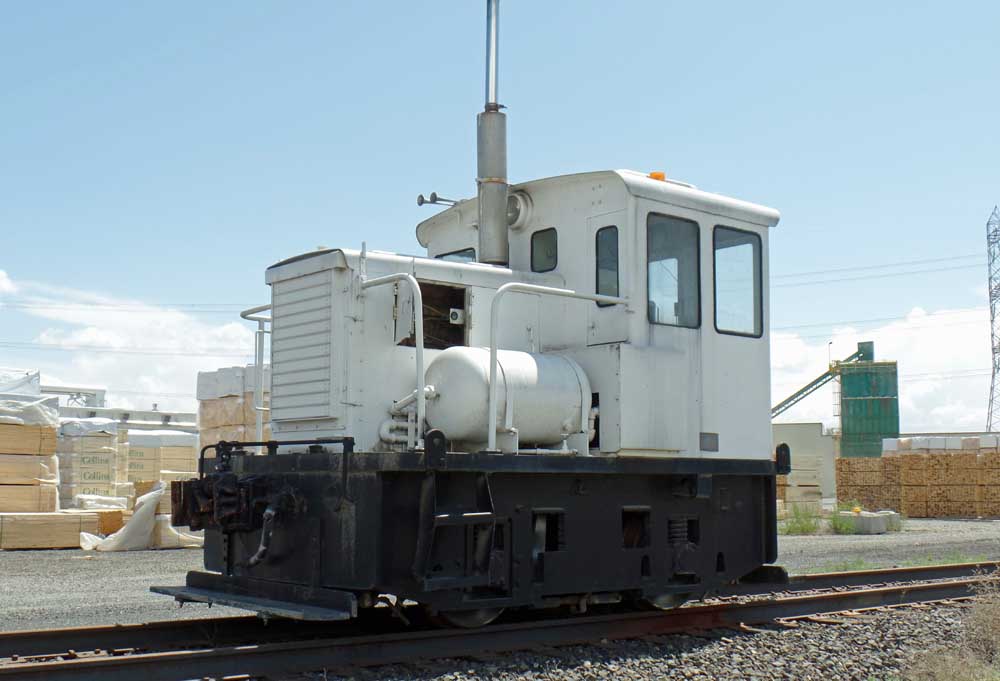 A fixture on the operation for many years has been the GE 25-ton switcher formerly used on the Les Dalles Portage Railroad. Jim Heringer photo. 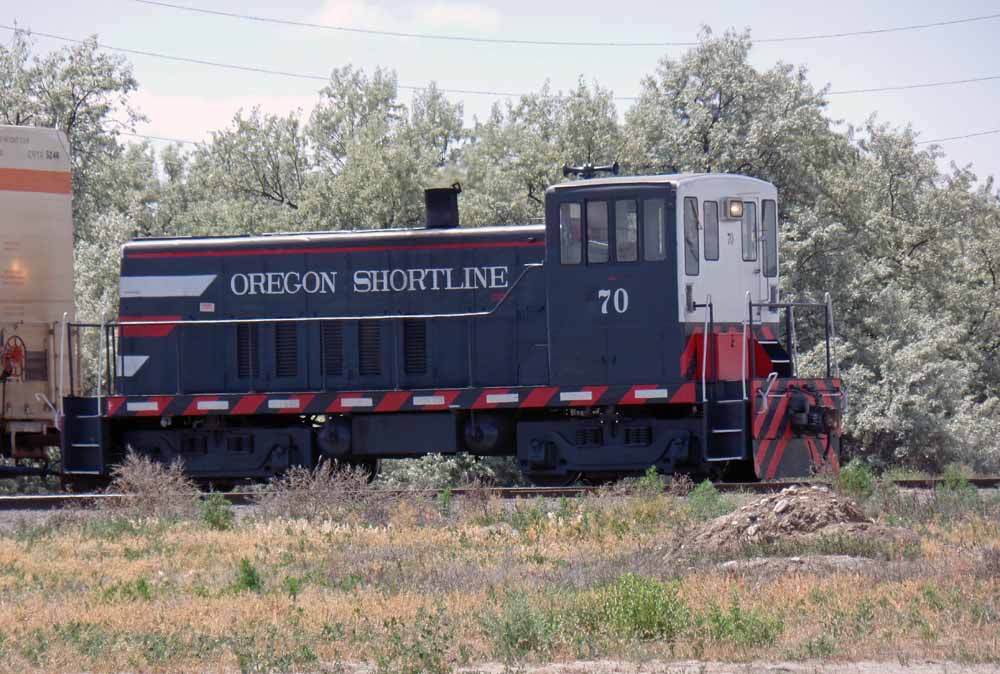
Frontier commenced operations with this General Electric 70-tonner, formerly owned by Lehigh Portland Cement/Lefarge Cement, Pend Orielle Valley Railroad, and
Almanor Railroad, and leased from Oregon Shortline LLC. Jim Heringer photo. 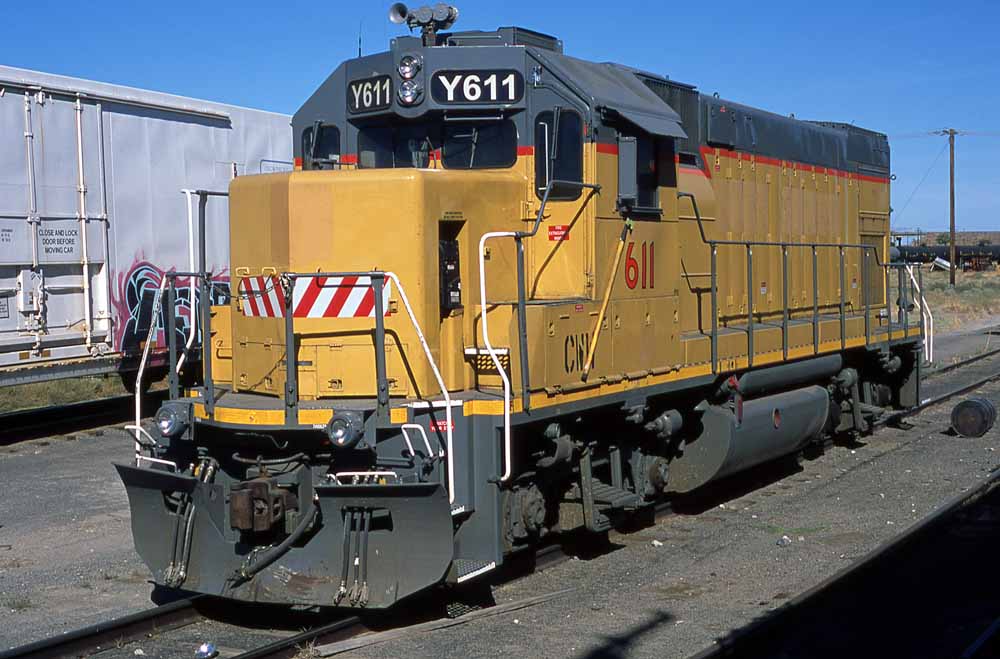
Columbia Walla Walla GP15-1 #Y611 is one of many locomotives Fronier/Columbia Rail has cycled through the Port. Keith E. Ardinger photo. More on the Web Columbia Rail homepage Port of Morrow homepage |
|
|
|
Masters-Ewoldt Lumber Company Sometime prior to 1912 the Wilcox Lumber Company built a small sawmill up Ladd Canyon, south and east of Hot Lake. In 1912 the Masters-Ewoldt Lumber Company, associated with the Rathborne, Hair, & Ridgeway Company, a large Chicago-based box manufacturer, purchased the mill. In the fall of that year the new owner started construction on seven miles of narrow gauge railroad extending from Lone Tree, a station on the O-WR&N main line, south and east to the mill site. The owners also built a planing mill at Lone Tree, and the railroad was used to haul rough cut lumber from the sawmill to the planing mill. At least some sources indicate there may have been a logging railroad built from the mill into the timber, but the reported mileages for the company don't necessarily support those claims. The sawmill by the late summer of 1913 was cutting 50,000 board feet a day, with a second contract band mill cutting an additional 25,000 feet a day of the company's timber. Total reported cut by the end of the year stood at four million board feet. J.F. "Fred" Ravencroft, formerly of the Nibly-Mimnaugh operations at Wallowa, managed the operation. A single small two-truck Climax locomotive purchased new provided the power for the railroad. Kramer Adams Logging Railroads of the West showed the operation ending around 1913, though it may have lasted for several years beyond that. 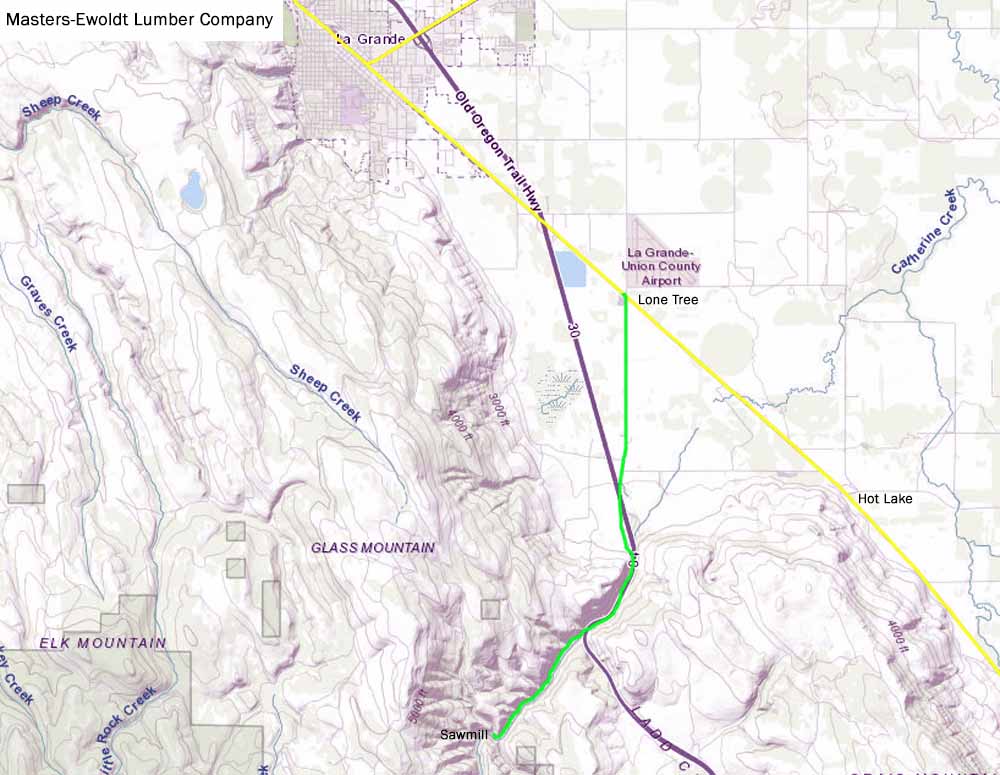 Map of the Masters-Ewold railroad. 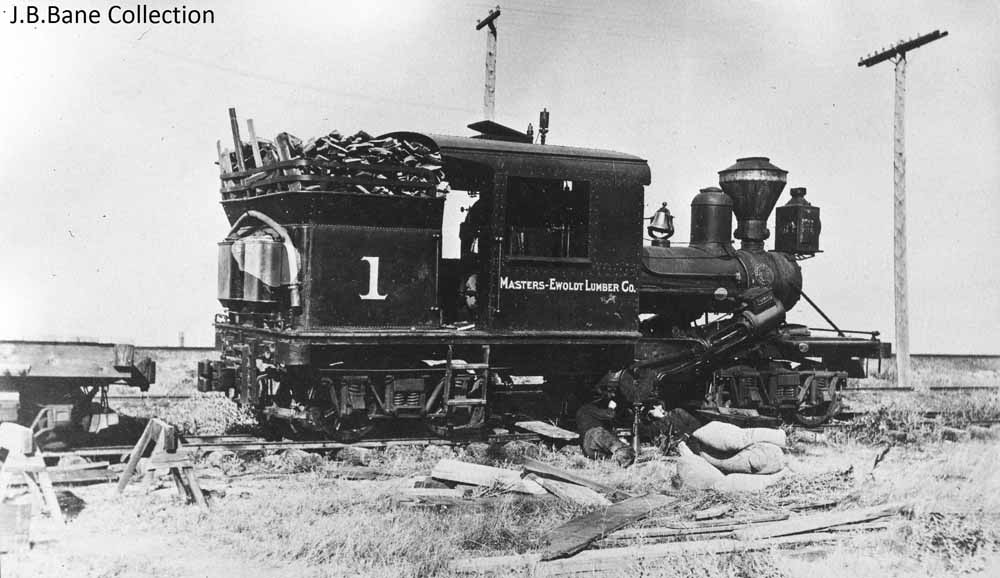
Masters-Ewoldt Lumber Company #1, built 4/1913 by Climax new for the company as their construction number 1219. Sold circa 1922 to Bay Logging Company, Raymond, WA,
then sold 1925 to Niagara Logging Company, Rayomond, WA. Subsequent disposition unrecorded. |
|
|
|
Meacham Lumber Company Daniel Chaplin, a trained surveyor, was born in New York in 1823 and later moved to Michigan. In 1854 Chaplin joined the hordes of settlers heading for Oregon over the Oregon Trail. Like many others he initially settled in the Willamette Valley, where he lived in a couple different places. However, in 1861 he headed back east to northeastern Oregon, where he became one of the first settlers in the Grande Ronde valley. Chaplin laid out the town of La Grande, the city to which he devoted much of the rest of his life. Chaplin got very interested in railroads later in his life, and he gifted 100 acres to the Oregon Railway & Navigation Company when it reached town that helped to ensure the city got the division headquarters and roundhouse and shops and other facilities that went a long ways towards ensuring La Grande became the dominate city in Union County. Chaplin then parlayed his relationship with the railroad into commercial timber operations, largely to provide lumber and other construction materials to the railroad, and by his death in 1887 he operated sawmills at Hilgard and Meacham. Charles W. Nibley, one of the group of Church of Jesus Christ of Latter-day Saints capitalists that followed David Eccles west to Oregon, acquired Chaplin's timber operations by around 1890. The Hilgard mill became the nucleus of the Grande Ronde Lumber Company, operated in association with the Stoddard and other interests, which relocated the mill to Perry. Nibley eventually incorporated the Meacham Lumber Company to take over operations of the Meacham mill. Construction of a standard gauge logging railroad to haul timber to the Meacham mill commenced about 1906, with three miles reported to be in operation by the following year. Adams in Logging Railroads of the West listed the railroad as the Blue Mountain Railroad, affiliated with the Hilgard Lumber Company, which conflicts with other available information. The company initially acquired a new 22-ton Heisler, c/n 1091, built in June 1906, to power the road. Charles Wilson Nibley Jr., Nibley's son and one of the 24 children he fathered with his three wives, was credited as being the operation's manager in 1907. The railroad had been extended to four miles in length by 1908, and finally topped out at six miles in 1910. This final extension apparently required a larger locomotive, as in September 1910 Heisler built a 42-ton locomotive, their c/n 1188, for the operation. Interestingly enough, Heisler records showed this locomotive built for the Nibley Lumber Company as their #2, then later sold to Hilgard Lumber Company/Blue Mountain Railroad, both listed as being at Meacham. The end for the Meacham Lumber Company and its railroad came in 1911, when Nibley decided to move the sawmill from Meacham to Whitney on the Sumpter Valley Railway. The smaller Heisler may have been used in the Grande Ronde Lumber Company operations out of Perry before being sold, it later worked for Wilson & Mallory and then Columbia Tie & Timber Company, both out of Yacolt, Washington, and then finally the Broughton Lumber Company of Cooks, Washington. Nibley sent the larger Heisler to the Nibley-Mimnaugh Lumber Company out of Wallowa, another company in which he had an interest; it later worked for successor Bowman-Hicks Lumber Company before being sold to the Oregon Lumber Company out of Baker City, who converted it to narrow gauge and put it to work on its logging railroads tributary to the Sumpter Valley Railway. 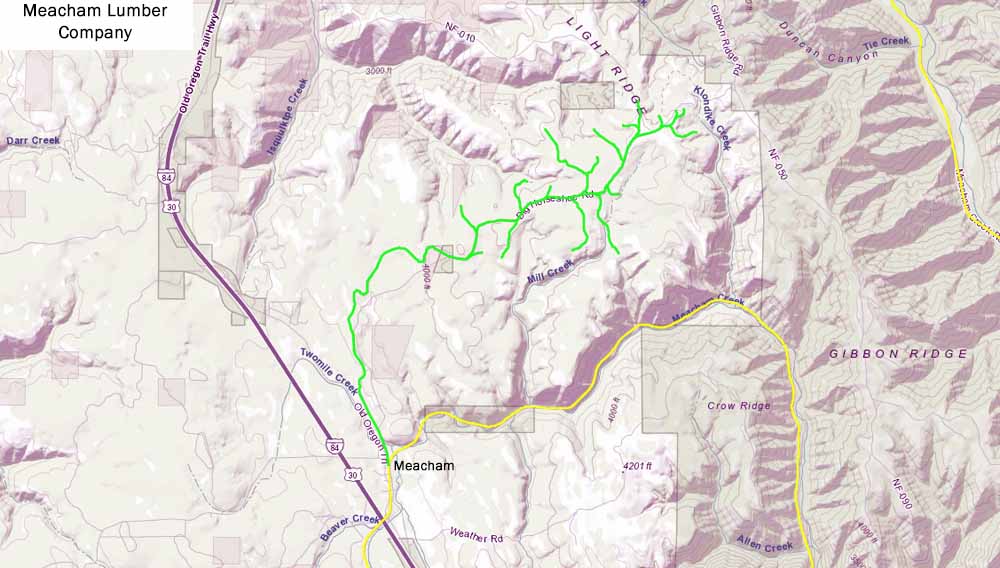
Speculative map of the Meacham Lumber Company. The first part of the line is fairly obvious in Oregon Deparment of Geology and Mineral Industry Lidar imagery, and
the branches depicted are at best probable based on Lidar and aerial imagery. 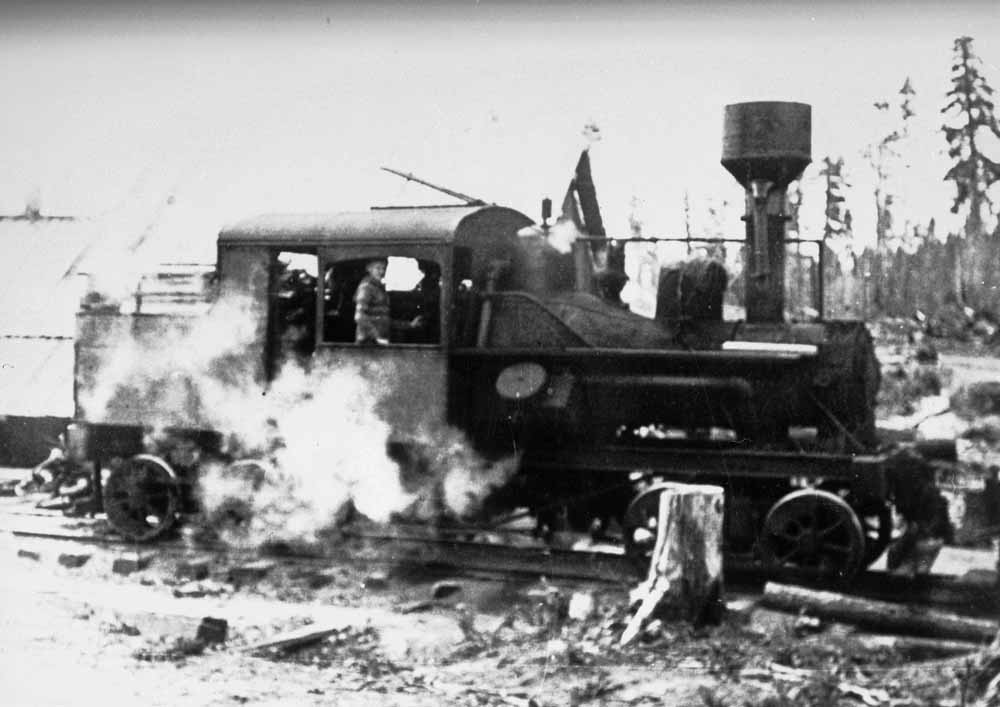
Heilser #1091, built new for the Meacham Lumber Company, is seen here working for the Broughton Lumber Company near the end of its life. John T. Labbe Collection of
Logging and Railroad Photographs, 1892-2010, Washington State Archives, Digital Archives, http://www.digitalarchives.wa.gov. 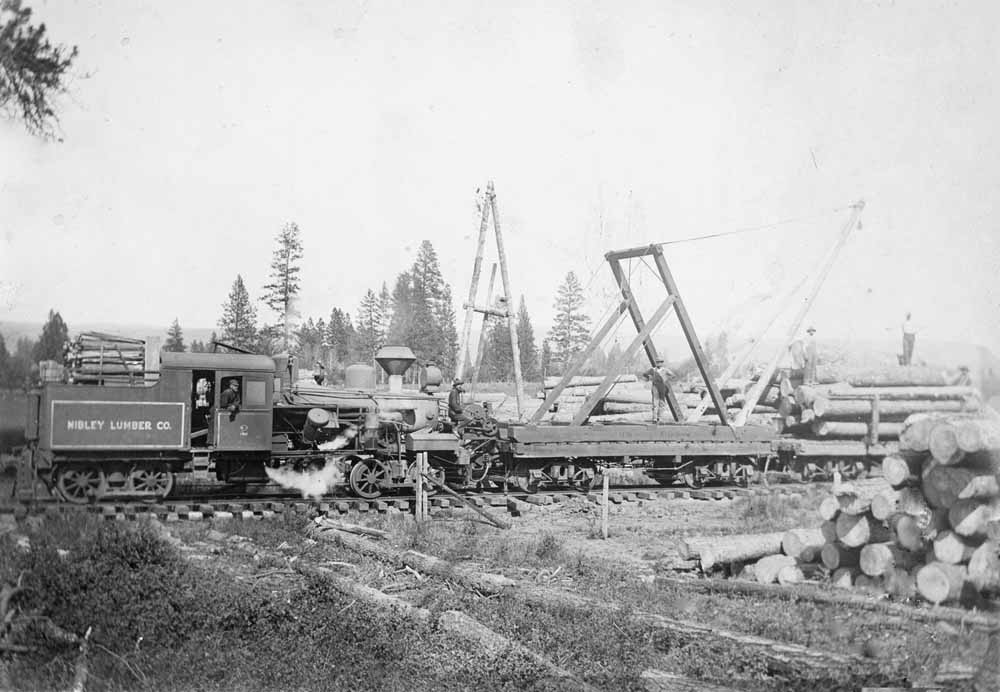
Nibley Lumber Company #2, likely working for the Nibley-Mimnaugh operations out of Wallowa. The location is thought to be on or around the mouth of Bear Creek south
of Wallowa. Martin E. Hansen collection. |
|
|
|
Others Various sources, including the Logging Railroads of the West by Kramer Adams, at least hint of the existence of other industrial railroad operations in eastern Oregon. Known or suggested operations are listed below. Some of the operations listed might not have existed at all, or may have been companies that did not operate any railroads but somehow ended up on one of the timber industry lists or registers from which Adams compiled his lists. - The U.S. Army Umatilla Ordnance Depot at one time had a vast railroad network that, while largely still intact, has been disconnected from the UP main line and is abandoned today. The Pacific Northwest Chapter of the National Railway Historical Society featured an article on the railroad that can be accessed at this link. The PDF document will open in a new window. The Depot does still occassionally produce rail traffic, which is all handled through the team tracks at the nearby Port of Morrow. - The Pine Tree Lumber Company is reported by Adams to have operated a mile of narrow gauge railroad in Bend in 1917-1919. The company is known to have used Shay construction number 62, which had been built in February 1883 for Henry Sherry & Company (Wood County Railroad) of Vesper, Wisconsin. The locomotive was apparently not a success as by July of that year it had been sold to Consolidated Lumber Company of Elk, Washington. The Shay later worked for Edwards & Bradfored Lumber Company, also of Elk, before being reported in Bend in December 1919, which would have been about the close of the Pine Tree operations. - O.R. Menefee Lumber Company and then Allen & Murphy Lumber Company are listed as operating somewhere in Grant County from an unrecorded date through 1921. No information on mileage or locomotives, or speceific location either. Could be associated with one of the other loggers associated with the Sumpter Valley Railway. - Crooked Creek Lumber Company is credited with one mile of track in Lakeview in 1926 and maybe 1927. The operation is not recorded in other sources about railroading in the Lakeview area. - Gardiner Lumber Company is listed as having an operation in the La Grande area in 1926. No other information. - Hammaker & Hild is credited with five miles of railroad in Lakeview in 1939-1940. No other information. - Klamath Logging & Timber Company is listed as having 4 miles of track and 1 geared locomotive at Odessa in circa 1917-1919. The dates and location strongly suggest this is likely part of, or affiliated with, or a mistaken name for the Pelican Bay Lumber Company operations in the area. - Klamath Timber Company is credited with two locomotives in Klamath Falls in circa 1942. - Moore Lumber Company is listed as having 12 miles of railroad out of Wallowa in 1940-1941. No other information. - Nicolle Brothers is shown as have two miles of railroad and one rod locomotive out of Odessa in 1916. - Chas B. Otey Lumber Company is listed as operating in Chiloquin in 1916-1919. No information on mileage or locomotives. - Pine Logging Company is shown as operating a mile of track in Klamath Falls in 1931-1933. - Rogers Lumber Company is listed with an operation in Prineville in 1919. No mileage or locomotive information. - H.E. Spencer is listed as being in Elgin in 1912. No other information. - J.J. Steiger is listed as being in Chiloquion circa 1916. No other information. - Wallowa Pine Lumber Company is credited as operating in Wallowa around 1922. No other information. |
|
|